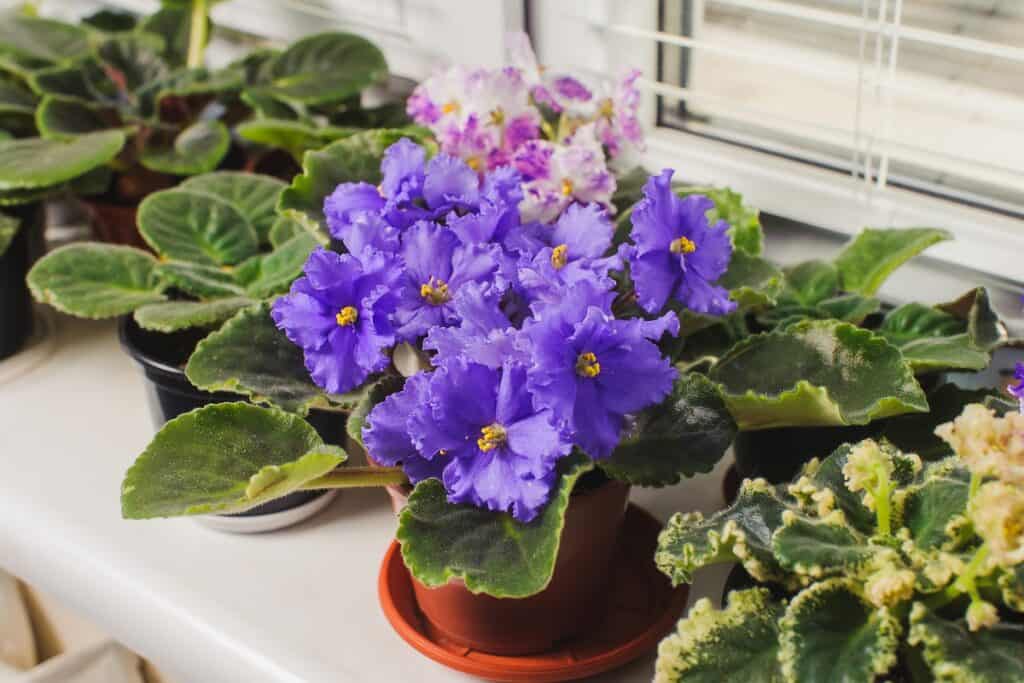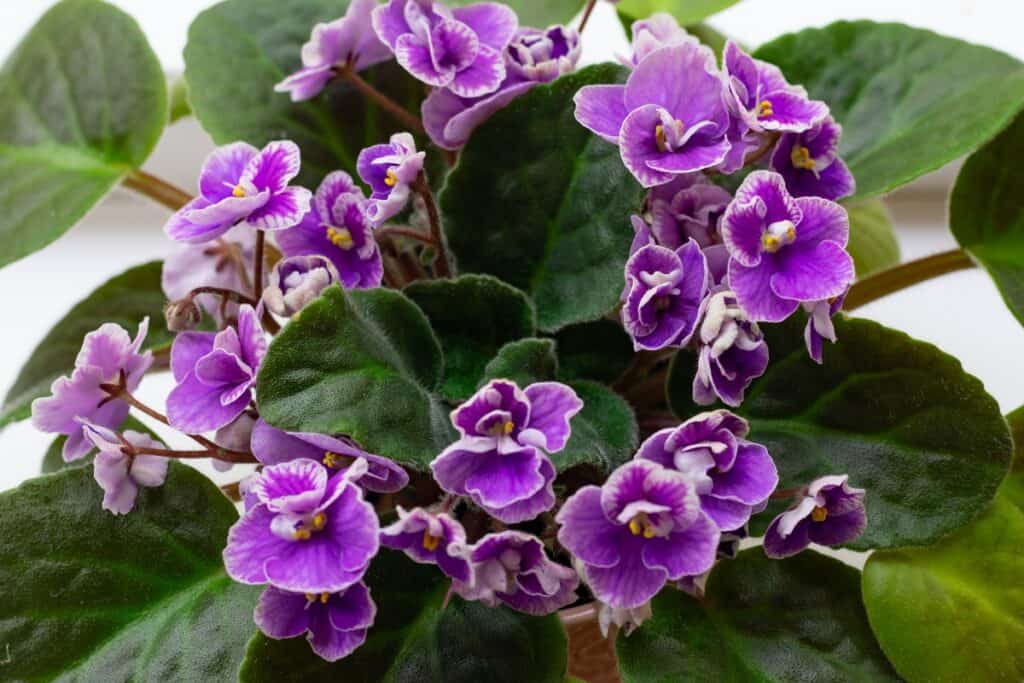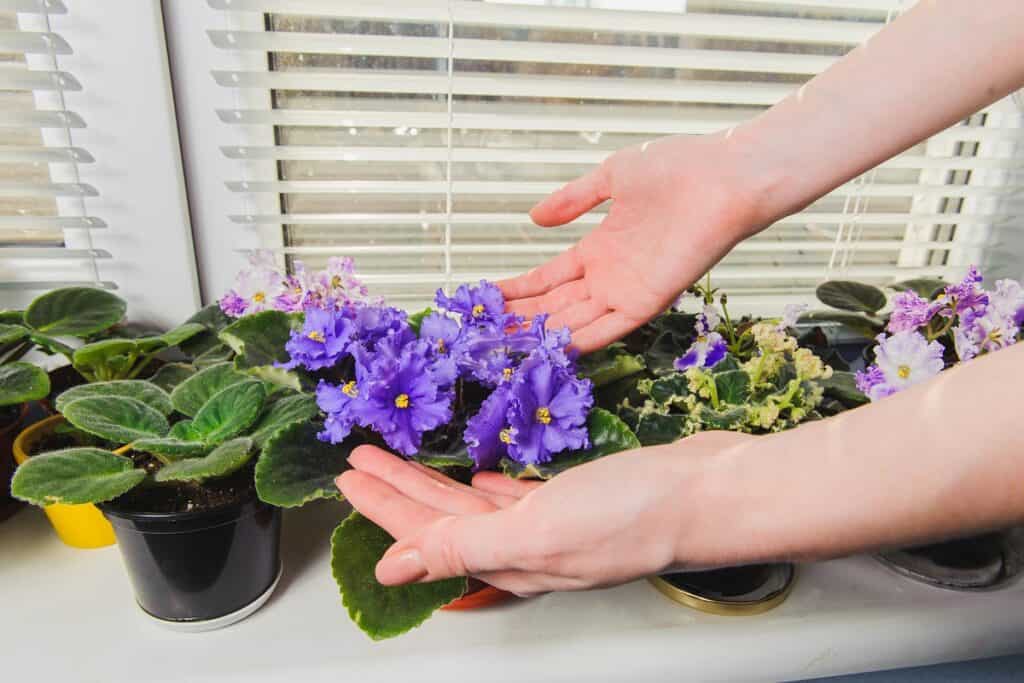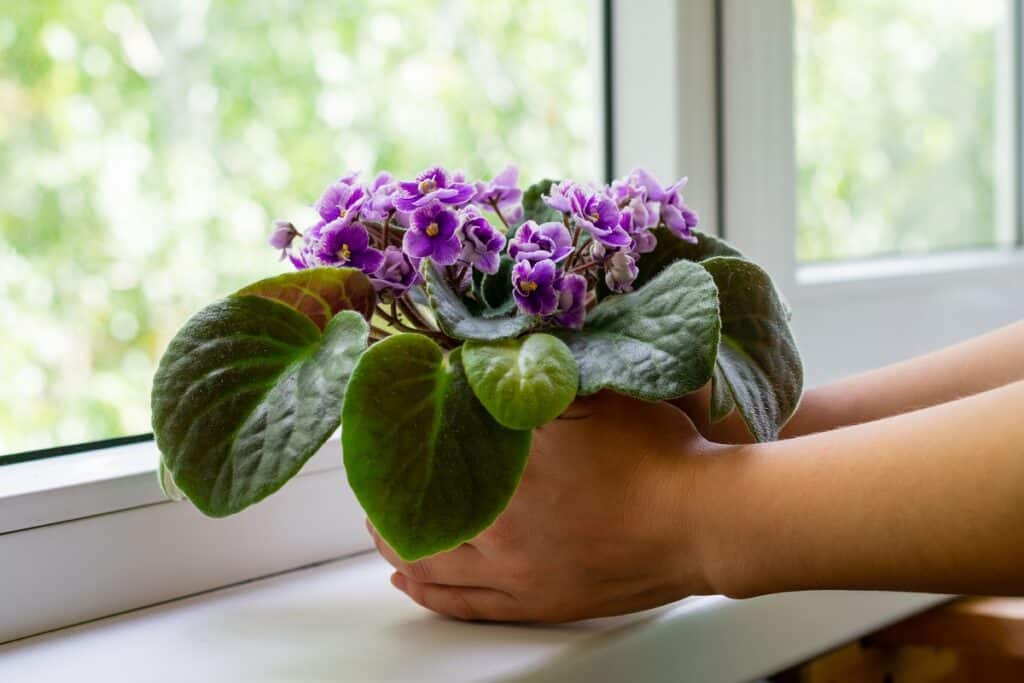If you’re the proud owner of these African Violets, you know that regular pruning is essential for maintaining their shape and encouraging new growth. In this post, we’ll teach you everything you need to know about how to prune your African violets. From the tools you’ll need to the proper techniques for cutting back your plants, we’ve got you covered. Whether you’re new to gardening or an experienced green thumb, our step-by-step guide on how to prune African violets will help you keep your plants looking healthy and beautiful.

Contents
- 1 How To Prune African Violets
- 2 When Is The Best Time To Prune African Violets?
- 3 How Much Should I Prune African Violets?
- 4 How Do I Prune African Violets For Best Blooming?
- 5 How Often Should African Violets Be Pruned?
- 6 Frequently Asked Questions
- 6.1 How many leaves should be on an African Violet plant?
- 6.2 When should I start my African Violet leaves?
- 6.3 Should I trim African violet leaves?
- 6.4 What do you do with African violet leaves?
- 6.5 Why are my African Violet leaves so long?
- 6.6 Why are my African violet leaves growing straight up?
- 6.7 Why are the tips of my African violet leaves turning brown?
- 6.8 Why do African violets leaves curl?
- 6.9 Can you regrow African violet from a leaf?
- 6.10 Should African violets be deadheaded?
- 6.11 How do you get African violets to bloom again?
- 6.12 What do you do when African violets get too big?
- 6.13 How do you keep African violets blooming all year?
- 6.14 How long does it take for African violets to rebloom?
- 7 Conclusion
How To Prune African Violets
1. Choosing The Right Pruning Tool
When pruning African Violets, it is important to choose the right pruning tool. Pruning tools should be sharp, clean, and sterile. This will help ensure that the plant is not injured and that any potential diseases or pests are not spread when pruning.
The best tools to use for pruning African Violets are scissors, shears, and pruning snips. These tools are sharp enough to make precise cuts and can also help to reduce the chances of spreading diseases or pests. It is important to make sure that the blades of these tools are clean and sterilized before using them to prune.
Another option for pruning African Violets is to use a sharp knife. This is not the preferred tool for pruning, as it can be difficult to make precise cuts with a knife. It is also important to be careful when using a knife to prune, as it can easily damage the plant.
2. Removing Damaged Leaves
The second step in pruning African violets is to remove any damaged leaves. Damaged leaves are those that are brown, yellow, or otherwise discolored. In some cases, the leaves may also have spots or be wilted. These leaves are usually easy to identify, as they will stand out from the healthy green leaves on the plant.
It is important to remove damaged leaves as soon as possible, as they can spread disease to the rest of the plant. To remove the leaves, use scissors or a sharp knife to cut them off at the base. Make sure to cut at an angle, so that the wound is small and will heal quickly.
Once the damaged leaves have been removed, it is important to dispose of them properly. Do not add them to a compost pile, as this could spread disease to other plants. Instead, throw them away to avoid further contamination.
It is also important to sterilize the scissors or knife used to remove the leaves. This can be done by wiping the blades with rubbing alcohol or a solution of bleach and water. Doing this will help to prevent the spreading of any diseases to the other leaves on the plant.
3. Pruning For Healthier Growth
Pruning for healthier growth is an important step in taking care of African violets. This type of pruning is used to eliminate overcrowding leaves, as well as to encourage new growth and larger blooms.
To begin pruning for healthier growth, start by inspecting the plant for leaves that are overcrowding or competing for nutrients and light. It is best to trim these away to allow other leaves to receive more light and space to grow. Make sure to trim the leaves above the node and not below it, as this will damage the plant.
Use scissors to carefully trim away any leaves that are long, thin, or overly abundant. This will help to create a more even shape and encourage new growth.
4. Avoiding Over-Pruning
When pruning African Violets, you should avoid over-pruning. Over-pruning is when a plant is pruned too much, which can lead to stunted growth and death. This is especially important for African Violets, as they have a delicate balance that must be kept in order to produce healthy flowers and leaves.
When pruning, be sure to not remove more than one-third of the leaves. Removing too many leaves can cause the plant to become stressed, which can lead to a decrease in growth and flowering. Additionally, avoid pruning the center of the plant, as this is where new growth will come from.

When Is The Best Time To Prune African Violets?
Pruning African violets is an important part of keeping them healthy and vibrant. However, knowing when to prune is just as important as knowing how to prune. The best time to prune African violets is when they are actively growing. This typically occurs in spring and summer when the days are longer and the temperatures are warmer.
When pruning, it is important to remove any dead, dying, or diseased leaves or stems. This will help to keep the plant healthy and prevent the spread of any potential diseases. Additionally, removing any old, overgrown or yellowing leaves or stems can help to stimulate new growth.
How Much Should I Prune African Violets?
When it comes to pruning African Violets, it is important to keep in mind that the goal is to keep the plant healthy and promote growth, not to completely remove new growth. Pruning should be done regularly to encourage healthy growth, but it is not necessary to be overly aggressive.
When pruning African Violets, it is important to not remove more than one-third of the plant at a time. Doing so can cause unnecessary shock and damage to the plant. It is also important to avoid pruning in areas where new growth is happening, as this can stunt the plant’s growth.
How Do I Prune African Violets For Best Blooming?
Pruning should be done carefully, using clean, sharp scissors or pruning shears. Begin by removing any dead or diseased leaves or stems. This will encourage new growth and help keep your African violets healthy.
Next, trim off any old flower stems and any long, straggly stems. This will help promote bushier growth and encourage more flowers. When pruning, make sure to leave at least two leaves on each stem, as this will help the plant to recover quickly from the pruning. Be sure to sterilize the scissors or shears with alcohol before and after each use to prevent the spread of disease between plants.
Finally, prune any leaves that are overlapping or crowding the center of the plant. This will help improve air circulation and light exposure and help keep the plant looking neat and tidy. With regular pruning, African violets will stay healthy and bloom more often.
How Often Should African Violets Be Pruned?
Knowing how often to prune African Violets is key to successful plant care. Most experts recommend pruning African Violets every 3-4 weeks. This is typically when the plant needs to be trimmed back to keep it from becoming overgrown. Pruning allows the plant to focus its energy on new growth and blooming, rather than maintaining a large, unruly plant.

Frequently Asked Questions
How many leaves should be on an African Violet plant?
There is no specific number of leaves that should be on an African Violet plant as it can vary depending on the age and size of the plant. A young African Violet plant may have only a few leaves, while a mature plant can have many more. It is normal for African Violets to lose a few leaves over time, but if the plant is losing a large number of leaves or the leaves are yellowing or wilting, it could be a sign of a problem such as over-watering or a lack of light.
When should I start my African Violet leaves?
African Violet leaves can be started from leaf or stem cuttings at any time of year. The best time to take a leaf cutting is when the plant is actively growing, which is typically during the spring and summer months. To start a leaf cutting, simply cut a healthy leaf from the plant, remove the lower half of the leaf blade, and place the cutting in soil or water to root. It can take several weeks for the cutting to root and form new leaves, but with proper care, it will eventually develop into a new plant.
Should I trim African violet leaves?
Trimming African violet leaves is not typically necessary, but you can remove any damaged or diseased leaves to help the plant stay healthy. If you do need to trim the leaves, use clean, sharp scissors or pruning shears and make a clean cut just above a leaf joint or stem. Avoid removing too many leaves at once, as this can stress the plant and reduce its ability to photosynthesize.
What do you do with African violet leaves?
You can dispose of African violet leaves that are damaged or diseased, or you can propagate new plants from the healthy leaves by taking leaf cuttings. To take a leaf cutting, follow the steps described above. Once the cutting has rooted and formed new leaves, you can pot it up in its own container with a well-draining soil mix.
Why are my African Violet leaves so long?
African Violet leaves may be long due to insufficient light, over-fertilization, or too much moisture. African Violets need bright, indirect light to thrive, but they should not be exposed to direct sun, which can scorch the leaves. If the plant is not getting enough light, the leaves may stretch out or become elongated in an attempt to reach for more light. Over-fertilization can also cause the leaves to grow too long, as can too much moisture, which can cause the leaves to become soft and limp.
Why are my African violet leaves growing straight up?
African violet leaves may grow straight up if the plant is not getting enough light or if the plant is overcrowded and needs to be divided. African Violets need bright, indirect light to thrive, and if the plant is not getting enough light, the leaves may grow upright in an attempt to reach for more light.
Alternatively, if the plant is overcrowded and the roots are not getting enough room to grow, the leaves may also grow upright. In either case, you can try moving the plant to a location with more light or dividing the plant to give the roots more room to grow.
Why are the tips of my African violet leaves turning brown?
The tips of African violet leaves may turn brown due to over-watering, under-watering, or a lack of humidity. Over-watering can cause the tips of the leaves to become soggy and brown, while under-watering can cause the tips to become dry and crispy. A lack of humidity can also cause the leaves to dry out and turn brown, particularly if the plant is in a dry, air-conditioned room.
To prevent brown tips, make sure the plant is getting the right amount of water and try misting the leaves with water or using a humidifier to increase the humidity around the plant.
Why do African violets leaves curl?
African violet leaves may curl due to over-watering, under-watering, pests, or a lack of humidity. Over-watering can cause the leaves to become soggy and curl downward, while under-watering can cause the leaves to become dry and curl inward. Pests such as aphids or mites can also cause the leaves to curl as they feed on the plant’s sap. A lack of humidity can also cause the leaves to curl, particularly if the plant is in a dry, air-conditioned room. To prevent leaf curling, make sure the plant is getting the right amount of water and try increasing the humidity around the plant.

Can you regrow African violet from a leaf?
Yes, it is possible to regrow African violets from a leaf by taking a leaf cutting and rooting it in soil or water. To take a leaf cutting, follow the steps described above. Once the cutting has rooted and formed new leaves, you can pot it up in its own container with a well-draining soil mix.
Should African violets be deadheaded?
African violets do not need to be deadheaded, but you can remove spent flowers to help the plant focus its energy on new growth. Deadheading involves removing the faded flowers from the plant to prevent them from setting seed. This can help the plant redirect its energy into producing new flowers and foliage rather than seeds. To deadhead an African violet, simply snip off the faded flowers just above the nearest leaf joint or stem.
How do you get African violets to bloom again?
To get African violets to bloom again, make sure they are getting enough light and fertilize regularly with a balanced fertilizer. You can also try providing additional humidity. African violets need bright, indirect light to thrive, and they should be fertilized every two to four weeks during the growing season with a balanced fertilizer. Providing additional humidity can also help encourage blooming, as African violets prefer a humidity level of around 50%.
What do you do when African violets get too big?
If your African violets are getting too big, you can divide them by carefully separating the rooted offsets and planting them in their own pots. African violets can grow quite large over time, and dividing the plant can help keep it a more manageable size. To divide an African violet, gently lift the plant out of its pot and shake off the excess soil. Carefully separate the offsets, making sure each one has a good root system, and pot them up in their own containers with a well-draining soil mix.
How do you keep African violets blooming all year?
To keep African violets blooming all year, make sure they are getting enough light and fertilize regularly with a balanced fertilize. You can also try providing additional humidity. African violets need bright, indirect light to thrive, and they should be fertilized every two to four weeks during the growing season with a balanced fertilize. Providing additional humidity can also help encourage blooming, as African violets prefer a humidity level of around 50%.
How long does it take for African violets to rebloom?
It can take several weeks for African violets to rebloom after the flowers have faded. The exact amount of time will depend on the age and health of the plant, as well as the care it is receiving. To encourage reblooming, make sure the plant is getting enough light, fertilize regularly with a balanced fertilize, and provide additional humidity if needed. With proper care, your African violets should begin to produce new flowers in a few weeks.
Conclusion
In conclusion, pruning African violets is not a difficult task. With a few simple steps, you can easily and quickly keep your African violets looking beautiful and healthy. Remember to use sharp and clean pruning tools, don’t be overly aggressive, and prune in the early morning or evening. With a little practice and patience, you too can have a healthy and vibrant African violet plant.
